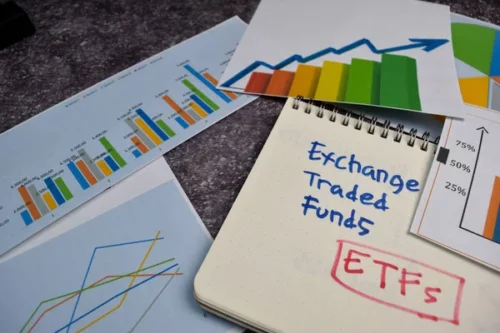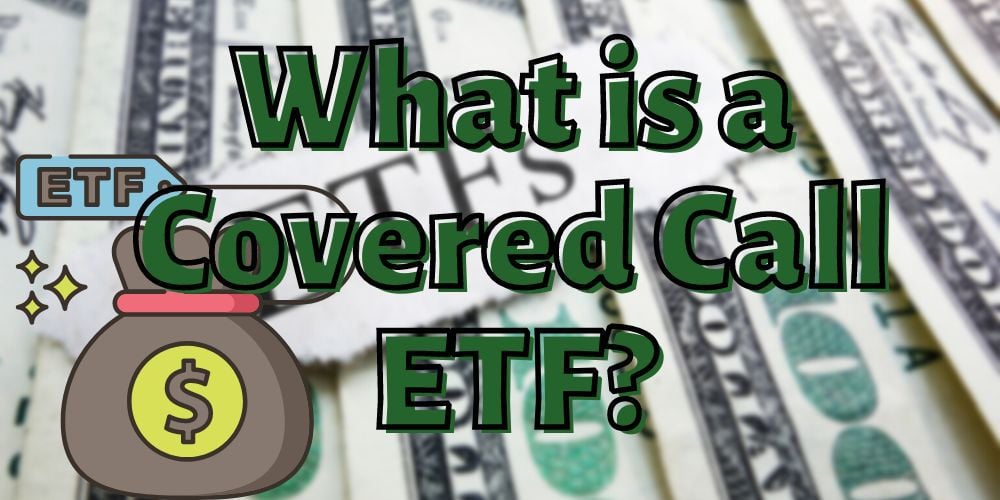Traders are looking for ways to minimize risk and generate steady earnings even when the market is volatile. A covered call ETF can offer high yields in such a scenario.
But what is a covered call ETF, how does it work, and should you invest in it? We answer these questions below.
About ETFs
Exchange-traded funds or ETFs are a type of pooled investment security that combines investor funds to create a basket of financial assets.
They can trade in equities, commodities, bonds, precious metals, or other similar instruments.
While a portfolio manager can structure ETFs to follow diverse investment strategies, most are passive and only track indexes.

These funds can be bought or sold on a stock market like stocks.
This makes them highly liquid.
Moreover, they usually have low expense ratios and don’t carry high management fees and sales commissions.
These points set them apart from mutual funds, another type of pooled financial asset that is often compared to ETFs.
What Is a Covered Call ETF?
Covered call ETFs provide additional earnings for investors apart from stock dividends. They do this by selling calls on the underlying holdings in their portfolio.
Unitholders in these funds can indirectly benefit from the options market without getting involved.
The earnings we mentioned come from the premium the ETF gets by selling covered calls on the stocks held (explained in detail in the next section).
However, the derivative action also creates a downside for these funds.
The profits get capped at the strike price of the call options (plus whatever premium was gained by selling them).
A covered call strategy can work well in a market where traders expect the index not to increase significantly in the short term.
What is a Covered Call?
Covered Call is an investment strategy where a trader with a long position in a particular asset also sells call options for the same.
Selling options generate money because a premium is received for them.
This method offers earnings even if the underlying shares do not grow in price.
That is an enticing proposition if the investor believes the stock has no upside in the near term.
If the reverse happens, the call options will get exercised when they reach the strike price.
At that point, the trader can cover the option exercise from their existing holdings.

This is why the tactic is called a “covered” call.
Until the exercise price is reached, however, investors get dual benefits.
Any growth in the value of the underlying holdings and the money received as a premium from option buyers go into their pockets.
On the other hand, there is no downside protection in this play.
Theoretically, the share could fall to zero.
In that case, the trader would only have the option premiums left in their hands.
How Do Covered Call ETFs Work?
If all of the above seems confusing and intimidating to you, it is not surprising.
Understanding how options work can be a bit complex. This is exactly where covered call ETFs come in.
These funds do all the work for their investors automatically. It helps them to generate additional earnings.
ETF managers select a clutch of stocks for this strategy periodically. Then, they write call options on that basket of shares.
The options usually have a strike price close to the current stock price.
This increases their premiums and hence potential dividends for investors.
Covered call strategies work better in a volatile market because they increase the premiums of the call options.
This is because call options give traders a choice to get potential upsides from stocks without facing the risk of a fall in their price.
What Are the Benefits of a Covered Call ETF?
As mentioned earlier, covered call ETFs take the complexity out of the strategy, but that’s not all they do.
Here are some more advantages of having them.
Better Returns
An at-the-money covered call in the S&P 500 can yield higher returns than the index itself.
Data from Chicago Board Options Exchange (CBOE) between June 30, 1986, to December 31, 2011, shows that this method achieved an 830% return.
The S&P 500 rose only by 807% in comparison.

Please note that this is their past performance and may not repeat in the future.
As discussed earlier, covered calls do better when there is higher volatility in the S&P 500.
Hence, it makes sense that these ETFs yielded better results during uncertain periods.
Volatility Protection
Apart from performing better during volatile scenarios, the trading strategy of these funds itself is less risky.
As per the same data, these ETFs have a 30% lower long-term volatility than the S&P 500.
Their returns are more stable, and during periods with more ups and downs, they are higher as well.

This makes covered call ETF investing a powerful hedging strategy for when the market is in choppy waters.
Moreover, the higher premium received during a downturn also helps to mitigate any losses if the index goes down.
Hedging
The return pattern of a covered call ETF is very different from the normal market.
It does well during bad years when there is a lot of fear and uncertainty.
The method may not offer great returns when the market is stable and growing.
In a way, having these ETFs mitigates losses during downturns and helps to hedge investments.
Simplification
Creating a covered call and setting up the right options might be difficult, even for experienced traders.
These ETFs do all of the work and take away the complexity of the task.
Traders reap the rewards of the strategy at a very marginal cost.
What are the Disadvantages of Covered Call ETFs?
While they can offer good returns at times, covered call ETFs also have problems.
We mention some of them below.

Limited Capital Appreciation
As soon as the option becomes in the money, the covered call strategy does not offer any further returns.
This is why such ETFs typically focus on distributing dividends rather than growing the invested value.
When the markets are doing well, regular funds might offer much higher returns than them.
No Downside Protection
As mentioned earlier, covered calls can potentially go down to zero with the stock price.
Even though ETFs diversify the risk of individual stocks losing value, a broad market downturn can still hurt these instruments.
Despite the option premium, if the net asset value declines, investors could have a bigger loss.
Perform Poorly During Low Volatility
When markets are stable and volatility is low, it has an inverse effect on option premiums, which start to fall.
This could reduce the earning potential of these ETFs.
Can You Lose Money on a Covered Call?
Yes, in fact, a covered call does not offer any downside protection.
If the price of the security goes down, the investor is liable to lose money.
The only positive is that they still get to keep the option premium earned.
For those who want protection from losses, other hedging strategies, such as buying put options, might be better suited.
Is It a Good Investment?
During times of uncertainty, covered call ETFs can provide much sought-after security.
Moreover, the option premiums can become a strong source of cash earnings.
But their limited possibility of growth makes these assets less lucrative when the markets are doing well.
Whether they are a good investment for folks also depends on their risk appetite and trading strategy.
Covered call ETFs are one of the less risky instruments, but their growth potential is also not too good.
This strategy could offer better earnings than corporate bonds, dividend stocks, and ETFs.
But they are for investors who want steady incomes during uncertain times.
Final Thoughts
Covered call ETFs generate dividends by selling call options on their underlying holdings.
They could offer a high yield to their investors when markets are volatile.
These funds also reduce complexity for the investor by handing over all the difficult work to the fund manager.
But for all their benefits, they also have some downsides.
The biggest problem is that their potential for capital appreciation is limited to the strike price of the options they created.
Moreover, their earnings are dependent on market uncertainty. In a stable market, their potential is limited.


 Tags:
Tags:










